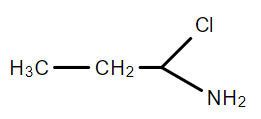
When\[C{H_3}C{H_2}CHC{l_2}\] is treated with $NaN{H_2}$ , the product formed is:
A.
B.
C.
D.
Answer
221.4k+ views
Hint: To answer this question recall the methods for the preparation of alkyne from dihalides. Sodium amide is a strong reducing agent which removes the halide atoms and generates an alkyne.
Complete Step by step answer:
We know that Sodium amide ($NaN{H_2}$) is a strong base and is used for deprotonation of weak acids and also for elimination reactions. Treatment of either geminal dihalide (two halogens on one carbon) or vicinal dihalides (halogens on adjacent carbons) with two equivalents of $NaN{H_2}$ results in the formation of alkynes.
Understanding the mechanism of this reaction is important: First, there is deprotonation of functional groups which is what is known as initiation of an elimination reaction. In this case, halide atoms are removed to form the alkene. Specifically, this is an example of an E2 (elimination 2) reaction.
Since the alkene still has a halide attached, this too can be removed to generate a second double bond (π bond).
The mechanism of this reaction can be shown as:

We can see from the above reaction that we receive an alkyne as the major product of the reaction.
Therefore, we can conclude that the correct answer to this question is option B.
Note: We should keep in mind the formation of terminal alkynes by use of this reaction mechanism. The acidity of terminal alkynes plays an important role in major product determination when dihalides undergo base induced elimination reactions. High electronegativity of the triple bond in terminal alkynes makes the molecule acidic. Therefore, one of the base molecules will pull off the terminal hydrogen instead of one of the halides like we desire to happen in this reaction. This implies that we would need three bases for every terminal haloalkane instead of two to obtain an alkyne.
Complete Step by step answer:
We know that Sodium amide ($NaN{H_2}$) is a strong base and is used for deprotonation of weak acids and also for elimination reactions. Treatment of either geminal dihalide (two halogens on one carbon) or vicinal dihalides (halogens on adjacent carbons) with two equivalents of $NaN{H_2}$ results in the formation of alkynes.
Understanding the mechanism of this reaction is important: First, there is deprotonation of functional groups which is what is known as initiation of an elimination reaction. In this case, halide atoms are removed to form the alkene. Specifically, this is an example of an E2 (elimination 2) reaction.
Since the alkene still has a halide attached, this too can be removed to generate a second double bond (π bond).
The mechanism of this reaction can be shown as:

We can see from the above reaction that we receive an alkyne as the major product of the reaction.
Therefore, we can conclude that the correct answer to this question is option B.
Note: We should keep in mind the formation of terminal alkynes by use of this reaction mechanism. The acidity of terminal alkynes plays an important role in major product determination when dihalides undergo base induced elimination reactions. High electronegativity of the triple bond in terminal alkynes makes the molecule acidic. Therefore, one of the base molecules will pull off the terminal hydrogen instead of one of the halides like we desire to happen in this reaction. This implies that we would need three bases for every terminal haloalkane instead of two to obtain an alkyne.
Recently Updated Pages
JEE Main 2022 (July 26th Shift 1) Physics Question Paper with Answer Key

JEE Main 2022 (June 26th Shift 2) Chemistry Question Paper with Answer Key

Apparent Frequency Explained: Formula, Uses & Examples

JEE Main 2023 (January 30th Shift 2) Chemistry Question Paper with Answer Key

Displacement Current and Maxwell’s Equations Explained

JEE Main 2022 (June 29th Shift 1) Maths Question Paper with Answer Key

Trending doubts
Understanding Atomic Structure for Beginners

Understanding Average and RMS Value in Electrical Circuits

What Are Elastic Collisions in One Dimension?

Free Radical Substitution and Its Stepwise Mechanism

Understanding Geostationary and Geosynchronous Satellites

Understanding How a Current Loop Acts as a Magnetic Dipole

Other Pages
NCERT Solutions For Class 11 Chemistry Chapter 8 Redox Reactions in Hindi - 2025-26

JEE Advanced 2026 Notes

Understanding Entropy Changes in Different Processes

Common Ion Effect: Concept, Applications, and Problem-Solving

Devuthani Ekadashi 2025: Correct Date, Shubh Muhurat, Parana Time & Puja Vidhi

Difference Between Exothermic and Endothermic Reactions: Key Differences, Examples & Diagrams




